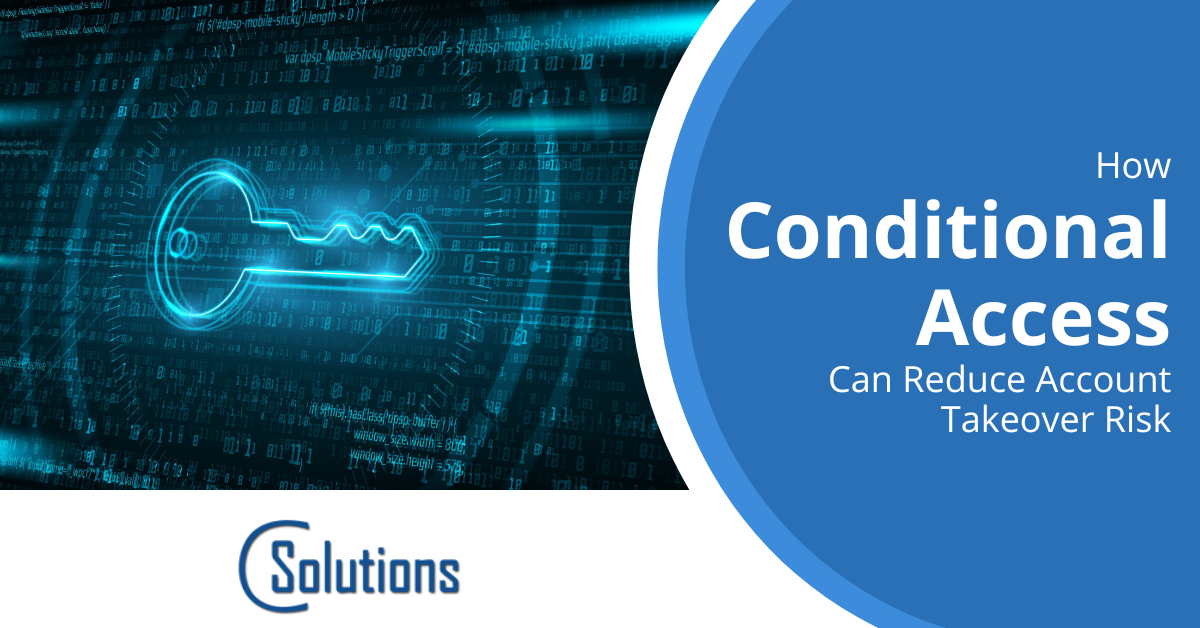How Conditional Access Can Reduce Account Takeover Risk

If you’re like most companies, you allow your employees to work from home at least some of the time. To enable this method of working, you no doubt use a range of cloud applications, which your employees can access from any device at any time.
While the cloud is excellent for facilitating remote productivity, it also causes some security concerns. If an employee’s password gets in the wrong hands, how can you ensure that the person logging onto your company’s applications and resources is legitimate? What if their account has been compromised by a hacker?
This issue is what’s known as account takeover, a form of attack where a threat actor illegally accesses their victim’s online accounts and then commits fraud. It’s one of the biggest security threats to organizations today. In fact, according to Microsoft research, account takeover threats cost consumers and businesses about $4 billion annually.
Here, we’ll explain how conditional access can help your company to tackle account takeover risk.
What Is Conditional Access?
Conditional access is an excellent tool to improve identity management and security in hybrid security. These systems work by enabling system administrators to set fine-tuned controls about what resources your employees can access based on contextual factors that are analyzed during the log-on process.
Unlike multi-factor authentication, which always requires employees to verify themselves using at least two mechanisms, conditional access intelligently analyzes the risks associated with an attempted log in to decide what authentication is needed beyond a password, if any.
The factors that conditional access systems typically look at include:
- Location data: Is the user logging on from an expected location, or somewhere suspicious and unusual?
- Data sensitivity: If the user is accessing sensitive information, they may need to verify their identity in multiple ways.
- IP address and network: Is the user logging in from a new device or unknown IP address?
- Browser: Is the user using a sanctioned browser or one that is deemed risky?
When the user logs on, conditional access looks at these factors at lightning speed and contrasts them with the conditional access policies you previously have set. Depending on the risk associated with the login, the system will either grant the user access, require more authentication or block the user entirely and send an alert to your IT provider.
Putting this into practice, let’s say a user attempts to access their account from an unknown device in an unusual location. It may be that they’re checking their work email while on holiday, or it could be a hacker attempting to get into their account! In this instance, conditional access would ask the user to verify themselves through multi-factor authentication.
By contrast, if an employee wanted to log-in from their home office on a trusted device, which they’ve done many times before, conditional access would deem this login low risk, and grant them access without any additional checks.
How Conditional Access Improves Security
Conditional access is the future of workplace identity and access management, offering a more intelligent, seamless and secure way for your employees to work.
With a well structured system in place, your organization will:
- Improve your security posture and reduce the risk of data breaches by dramatically lowering the risk of account takeover and identity fraud.
- Enhance the user experience by reducing the need for multi-factor authentication every time an employee logs in to corporate resources remotely. Research shows that overuse of multi-factor authentication increases friction for users, leading to frustration and lost productivity.
- Gain better control over your data, so only authorized employees access confidential information.
- Lower your cyber insurance premiums.
- Enable suppliers and partners to access segments of your systems, without the worry of data security issues.
- Be better prepared to meet data security regulations like the GDPR, HIPAA and GBLA.
Getting Started with Conditional Access
There are many conditional access solutions out there, including options from Microsoft and specialist providers like Okta. The system you choose will depend on your organizations needs. Don’t worry if you’re not sure which one is right for you. We can talk you through your options and help you install the most cost-effective and reliable option.
Once you’ve settled on a system, you’ll then need to think about the factors you want the solution to consider, along with the levels of access users will receive in response. We can assist you in setting your conditional access policies to ensure maximum security and an excellent user experience.
We can also monitor your conditional access solution for you as part of our network monitoring services, where we’ll ensure your systems are secure 24/7, while you focus on growing your business.
Unlock the Benefits of Conditional Access Today!
Thinking about moving your business systems to conditional access or want to learn more? We can help. Call 407-536-8381 or reach us online to start your journey.
